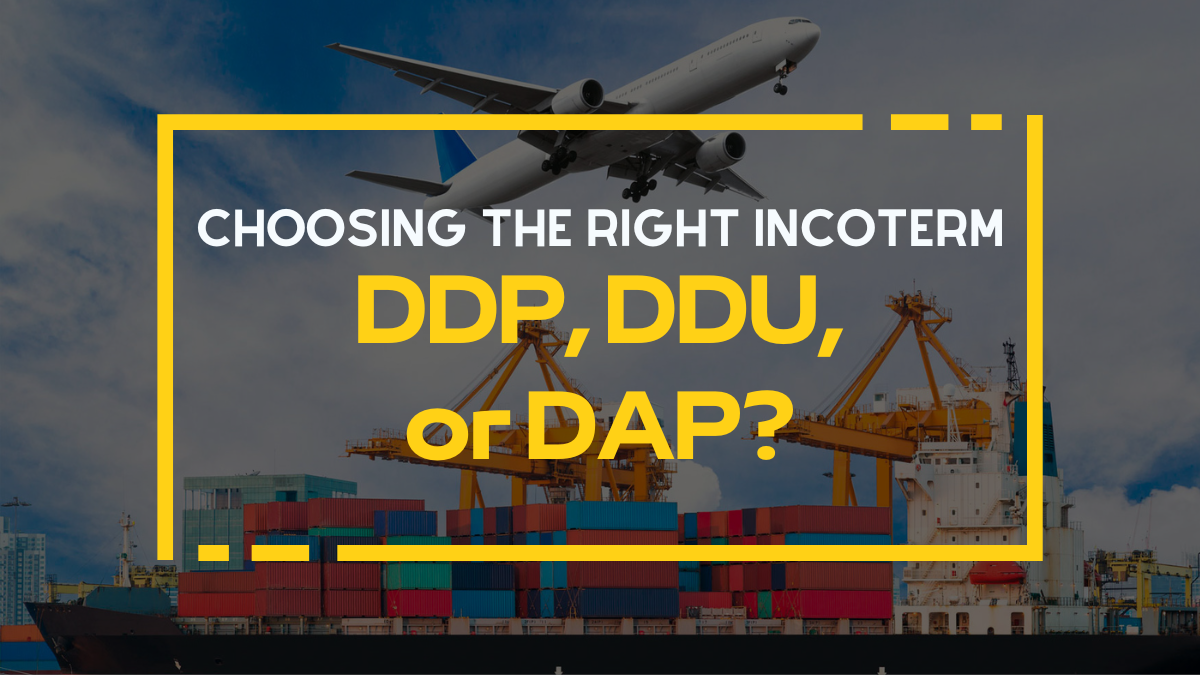1. What is CFR (Cost and Freight)?
Ever wondered what CFR really means and why it’s such a big deal in international shipping?
Well, you’re in the right place because I’m here to break it down for you. I’m writing this article to help you understand CFR so you can navigate global trade like a pro.
CFR, short for Cost and Freight, is one of those essential Incoterms you’ll run into if you’re dealing with international trade.
Simply put, CFR means that the seller is responsible for getting the goods to the port of destination and paying for the transportation.
But here’s the kicker: the moment those goods are loaded onto the vessel at the port of origin, the risk shifts from the seller to the buyer. So, while the seller is footing the bill for the transport, the buyer takes on all the risk once the goods are on that ship. It’s this clear split between cost and risk that makes CFR such an important term to wrap your head around.
Is CFR the Same as CNF?
Good question! Yes, CFR and CNF (Cost and No Insurance Freight) are basically twins—just with different names.
Both terms describe the same arrangement where the seller handles the transportation costs but doesn’t bother with insurance. The buyer, on the other hand, takes on the risk as soon as the goods are loaded onto the vessel. So, whether you see CFR or CNF, just know they’re pointing to the same deal.
2. What Are the Seller’s Responsibilities Under CFR?
Under the CFR Incoterm, the seller’s responsibilities are significant up until the goods are loaded onto the ship. Let’s explore these in detail:
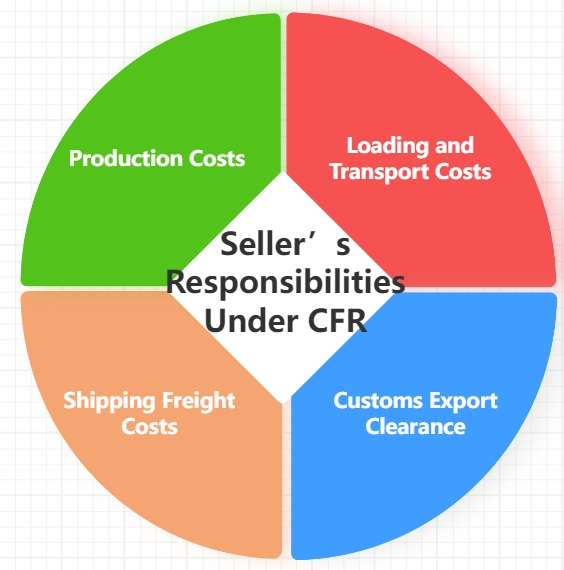
Production Costs
The first responsibility the seller bears is the cost of producing the goods. This encompasses all expenses related to raw materials, manufacturing, and quality control to ensure that the goods meet the standards required by the buyer’s country.
Loading and Transport Costs
Once the goods are ready, the seller must arrange for their transport from the production site to the port of origin. This includes any inland transportation costs, whether by truck, rail, or a combination of methods, depending on the location of the factory relative to the port.
At the port, the seller is also responsible for the costs associated with loading the goods onto the vessel. This includes handling charges, crane services, and port fees.
These costs can vary significantly depending on the port’s location and the nature of the goods being shipped. For example, heavier or more complex goods may require specialized equipment, increasing the loading costs.
Main Freight Costs
Let’s face it—freight costs have been a bit of a rollercoaster lately.
During the height of the pandemic, shipping rates shot up faster than a rocket, thanks to container shortages, port congestion, and limited capacity. At their worst in 2021, we saw rates hitting jaw-dropping levels, soaring up to $10,377 per FEU. Compare that to the pre-pandemic days when you could move a container for just $1,420, and you start to appreciate how wild things got.
Global container freight rate index from the 12th January 2023 to the 15th August 2024(in U.S. dollars per 40-foot container)
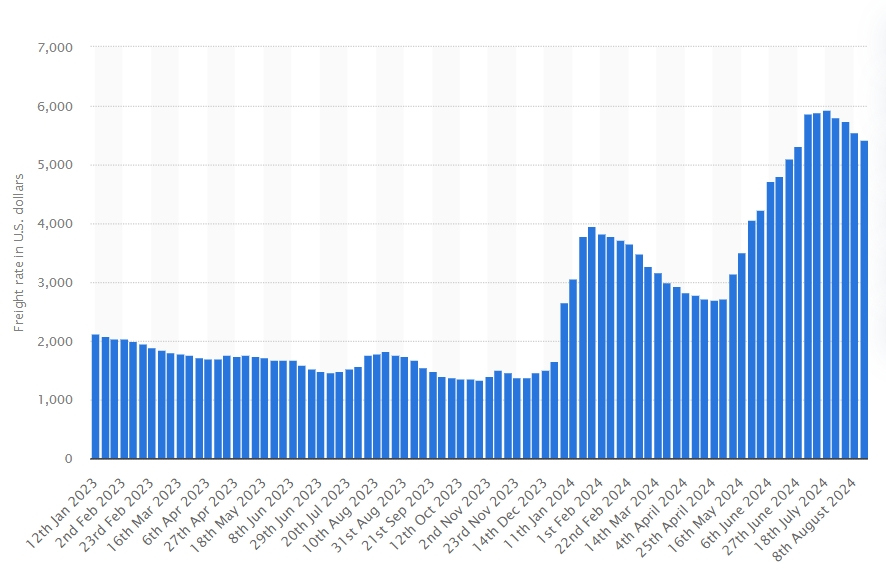
Now, fast forward to 2024, and while we’re not seeing the extreme highs of the pandemic, freight rates are on the rise again.
In fact, from April to May 2024, rates on key routes like the Far East to North Europe jumped by a whopping 30%, reaching $4,343 per FEU. The Far East to US West Coast route wasn’t far behind, with a 29% increase that pushed rates to $4,468 per FEU. And just to add a bit more fun to the mix, geopolitical tensions, port strikes, and fuel surcharges are all contributing to the chaos.
Amazon Shipping Costs in 2024:
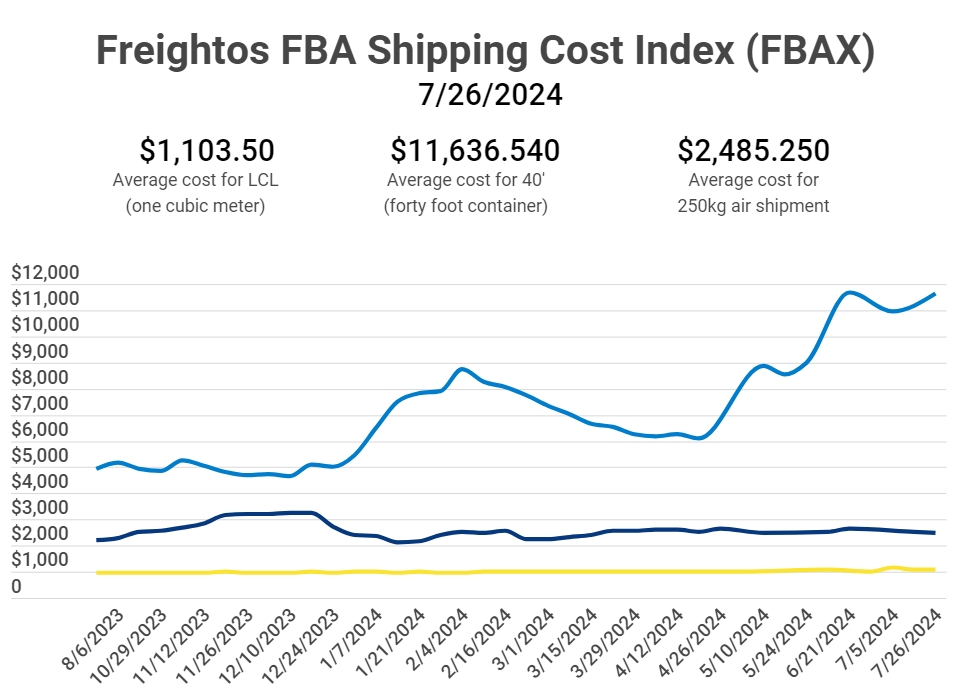
So, what does this mean for you? Well, both buyers and sellers need to have their game faces on when it comes to shipping agreements.
Sellers, if you’re quoting shipping rates, make sure you lock them in early because what’s cheap today might be a lot more expensive tomorrow.
Buyers, it’s a good idea to budget a little extra for any surprises—because those surprises tend to show up right when you least expect them.
Proactive Planning Tips:
- For Sellers: Keep a close eye on market trends, and don’t wait too long to lock in your freight rates. Make sure your quotes are valid long enough to cover any unexpected delays and adjust your pricing if needed to keep your margins safe.
- For Buyers: If you can, lock in those orders early to dodge those last-minute price hikes. And don’t forget to check in with your seller regularly to make sure everything’s on track. A little communication can go a long way in avoiding nasty surprises.
By staying ahead of the game and keeping a watchful eye on the shipping market, both buyers and sellers can navigate the unpredictable waters of global freight with a bit more confidence—and maybe even a little less stress.
Customs Export Clearance
Another critical responsibility for the seller is ensuring that the goods are cleared for export. This involves handling all necessary customs paperwork, securing export licenses, and ensuring compliance with any regulatory requirements in the country of origin. Failure to do so can result in costly delays or fines, which the seller will need to absorb.
The seller must provide all relevant documents to the buyer, including:
- Bill of Lading: This document serves as proof of shipment and allows the buyer to claim the goods at the destination port.
- Commercial Invoice: Detailing the transaction, this document outlines the price, quantity, and description of the goods.
- Packing List: A breakdown of the shipment’s contents, providing details such as dimensions, weight, and the number of items.
- Certificates of Origin: These confirm where the goods were produced, which may be necessary to qualify for reduced tariffs under trade agreements.
Accurate and timely documentation is essential to ensure that the shipment proceeds smoothly through customs and that the buyer can take possession of the goods without unnecessary delays.
3. What Are the Buyer’s Responsibilities Under CFR?
While CFR places significant cost burdens on the seller, the buyer assumes responsibility for several critical aspects once the goods are loaded onto the vessel. Here’s what every buyer needs to understand:
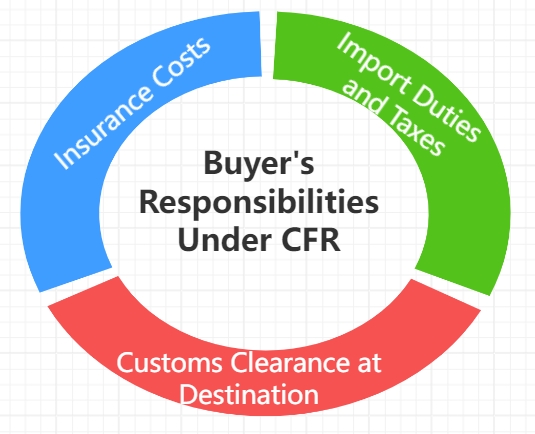
Insurance Costs
Under CFR, the seller is not obligated to insure the goods during transit. The risk transfers to the buyer the moment the goods are loaded onto the ship at the port of origin.
For this reason, buyers must carefully consider purchasing insurance to protect themselves against potential losses, such as damage during transit or theft.
For example, if you’re importing high-value items like electronics, it’s wise to purchase a comprehensive marine insurance policy that covers these risks. Even for lower-value shipments, unforeseen circumstances, such as rough seas, port mishaps, or piracy, can lead to substantial financial losses.
Insurance typically costs a small percentage of the shipment’s value and is well worth the investment for peace of mind. Buyers should inquire about coverage options through their freight forwarder or insurance broker and understand the various types of marine cargo insurance available.
Import Duties and Taxes
Once the goods arrive at the destination port, the buyer becomes responsible for paying all import duties, taxes, and other fees that are imposed by the destination country’s customs authorities. These duties are based on the declared value of the goods and their classification under the Harmonized System (HS) code.
For example, if you’re importing furniture into the United States, you’ll need to calculate import duties based on the type of material, design, and value of the furniture.
The duties can vary widely depending on the country of origin and any existing trade agreements, such as the USMCA or EU trade deals. Buyers should also be aware of any additional tariffs or duties that may apply due to anti-dumping regulations or specific restrictions placed by their government.
It’s essential for buyers to be proactive by calculating these costs before finalizing any agreements. Your freight forwarder or customs broker can assist with estimating these duties to ensure you’re not caught off guard when the goods arrive.
Customs Clearance at Destination
Once the goods arrive at the destination port, it’s the buyer’s responsibility to handle customs clearance. This includes submitting the appropriate paperwork, paying any additional fees or tariffs, and ensuring the goods comply with the destination country’s regulations.
The buyer will need to provide documentation such as the commercial invoice, bill of lading, and packing list to local customs officials. Failure to present the correct paperwork or fulfill regulatory requirements can result in significant delays, penalties, or even seizure of the goods.
For instance, if a buyer in Europe fails to meet CE marking standards for imported electronics, the shipment may be blocked by customs until compliance is achieved.
Working with a reliable customs broker can ease this process, ensuring that all regulations are met and that the clearance proceeds without issues. Delays in customs clearance can lead to additional port storage fees or demurrage charges, which can quickly accumulate and erode profits.
4. When Does Risk Transfer From Seller to Buyer in CFR?
Ever wonder exactly when the risk shifts from seller to buyer in a CFR deal? It’s simple: the moment those goods are loaded onto the ship at the port of origin, the buyer takes on the risk.

If something happens before loading—say, a crane drops your industrial machinery in Shanghai—the seller is on the hook. But once those goods are safely on board, any damage during transit, like rough seas en route to Rotterdam, is the buyer’s responsibility.
That’s why understanding this exact moment of risk transfer is crucial. Both parties need to make sure the bill of lading is crystal clear about the loading time and date, so there’s no confusion over when the buyer took on the risk.
Common Pitfalls and How to Avoid:
One of the biggest mistakes under CFR is thinking the seller is responsible until the goods reach the destination.
Not true!
Misunderstandings like this can lead to disputes if things go wrong during transit.
The solution?
Clear communication!
Both parties should make sure the terms of the contract are fully understood, and the buyer should arrange insurance to cover their risk. Also, keeping the lines of communication open with the seller and shipping company helps ensure everything runs smoothly when loading the goods.
5. Advantages and Disadvantages of CFR for Sellers and Buyers
For Sellers:
Advantages:
- Control Over Shipping: Sellers maintain control over the shipping process, allowing them to negotiate better rates with carriers and manage logistics more effectively.
- Predictable Costs: Since the seller is responsible for freight, they have a clearer understanding of the overall cost of shipping up to the destination port.
Disadvantages:
- Fluctuating Freight Rates: Sellers bear the risk of fluctuating freight rates between the time of contracting and shipment. This can erode profit margins if rates increase unexpectedly.
- Customs Complications: Any issues with customs documentation can lead to delays or fines, which the seller will need to address.
For Buyers:
Advantages:
- Simplified Responsibilities: Buyers benefit from simplified logistics, as the seller handles the shipping up to the port of destination. This reduces the burden on buyers, especially those unfamiliar with international shipping.
- Cost Certainty: Buyers know the exact shipping cost from the outset, helping them budget more effectively.
Disadvantages:
- Risk Transfer: The buyer assumes the risk for the goods once they are loaded onto the vessel. Without proper insurance, buyers could face significant financial losses in the event of damage or loss during transit.
- Limited Control: Buyers have limited control over the shipping process, which can be a disadvantage if delays occur or if the seller chooses a less reliable carrier.
Risk Management Tips:
To manage these challenges effectively, both buyers and sellers need to take proactive steps:
- For Sellers:
- Carefully monitor shipping market trends and ensure that freight quotes are valid for the duration needed to finalize contracts. Work closely with freight forwarders to lock in rates where possible.
- Provide clear, accurate, and complete documentation to the buyer well in advance of shipment. This ensures that the goods can pass through customs efficiently.
- Communicate clearly with the buyer regarding the transfer of risk, using precise language in contracts to avoid any confusion.
- Carefully monitor shipping market trends and ensure that freight quotes are valid for the duration needed to finalize contracts. Work closely with freight forwarders to lock in rates where possible.
- For Buyers:
- Consider purchasing marine cargo insurance to cover potential risks during transit. This will help protect against financial losses due to damage, theft, or other unforeseen incidents.
- Budget for potential increases in shipping costs and work with the seller to finalize shipping dates as early as possible.
- Engage with reliable customs brokers who are familiar with the regulations in your country to ensure smooth customs clearance.
- Consider purchasing marine cargo insurance to cover potential risks during transit. This will help protect against financial losses due to damage, theft, or other unforeseen incidents.
By staying informed and proactive, both parties can mitigate many of the risks associated with CFR agreements.
6. Comparison of CFR with Other Incoterms
While CFR is a commonly used Incoterm, it’s essential to compare it with others to determine which term best fits the needs of both parties in an international trade agreement.
CFR vs. CIF
CFR and CIF (Cost, Insurance, and Freight) are often compared because they are very similar. The key difference is that under CIF, the seller is also responsible for providing insurance coverage for the goods while they are in transit. This makes CIF a more comprehensive option for buyers who want the added security of insurance without arranging it themselves.
For example, a company shipping high-value medical equipment may prefer CIF to ensure that the goods are insured throughout the journey, reducing the buyer’s liability if the equipment is damaged during shipping.
When to Use CIF: CIF is typically used when the buyer prefers the seller to handle all logistics, including insurance, up until the goods arrive at the destination port. This is common when shipping valuable or delicate goods that require additional protection.
CFR vs. FOB
Under FOB (Free on Board), the risk and cost transfer to the buyer much earlier than under CFR. In FOB, the seller’s responsibility ends as soon as the goods are loaded onto the ship at the port of origin. The buyer is responsible for all costs and risks from that point forward, including ocean freight and insurance.
FOB is commonly used when the buyer has a strong logistics network and prefers to handle the shipping arrangements themselves. It offers more control to the buyer but also comes with increased risk and responsibility.
When to Use FOB: Buyers who want more control over the shipping process and have experience managing freight and insurance may prefer FOB.
CFR vs. EXW
EXW (Ex Works) represents the minimum obligation for the seller. Under EXW, the buyer assumes almost all responsibility, including picking up the goods from the seller’s premises and handling all transportation, export, and import formalities. EXW places the most risk and costs on the buyer, who must manage the entire logistics process from start to finish.
When to Use EXW: EXW is typically used when the buyer has the infrastructure and expertise to manage the entire logistics process. It’s often favored in cases where the buyer wants complete control over the shipment.
Comparison Table
| Incoterm | Seller’s Responsibilities | Buyer’s Responsibilities | Point of Risk Transfer | Insurance Responsibility |
|---|---|---|---|---|
| CFR | Covers transport to destination port | Manages insurance, import duties, and customs | When goods are loaded onto the ship | Buyer’s responsibility |
| CIF | Covers transport and insurance to destination port | Manages import duties and customs | When goods are loaded onto the ship | Seller’s responsibility |
| FOB | Covers transport to the ship | Manages freight, insurance, and customs | When goods are loaded onto the ship | Buyer’s responsibility |
| EXW | Provides goods at seller’s premises | Manages all transportation, freight, insurance, and customs | At seller’s premises | Buyer’s responsibility |
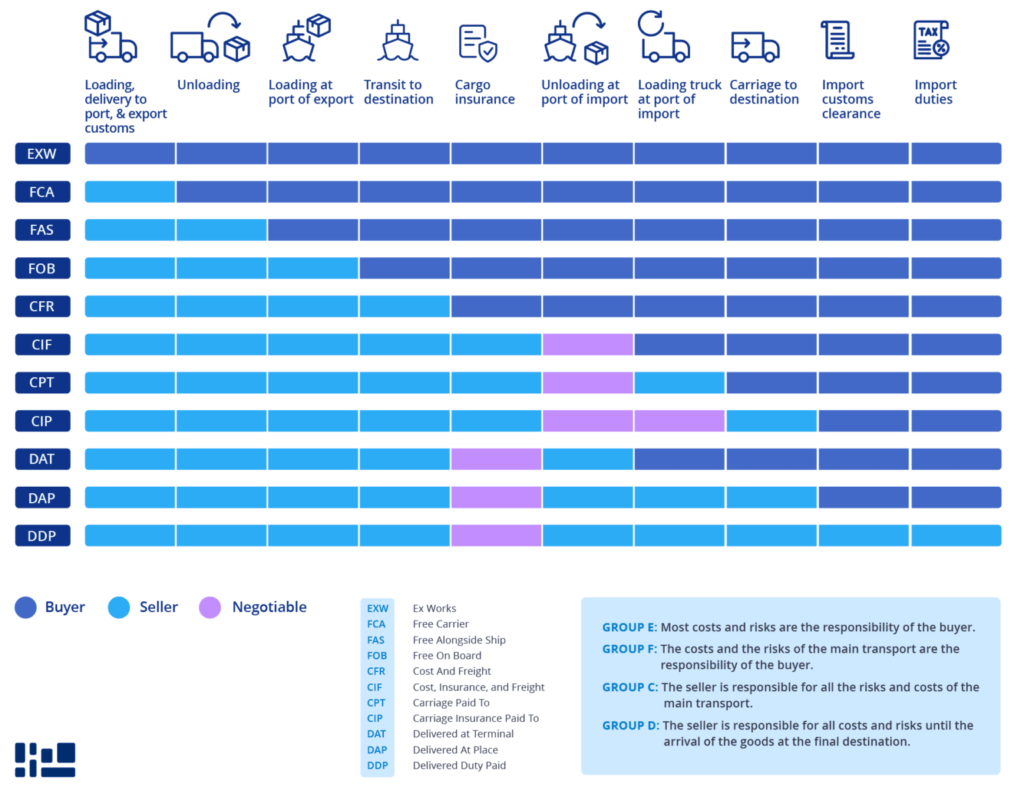
7. Country-Specific Considerations for CFR
How Different Countries Handle CFR
Customs procedures and port regulations can vary significantly from one country to another, which can impact how CFR agreements are executed.
For example, in the European Union, there are strict regulations around product standards, particularly for goods like electronics, textiles, and food products. If these standards are not met, shipments can be delayed or rejected altogether.
In the United States, the customs clearance process is largely governed by U.S. Customs and Border Protection (CBP), which requires accurate and thorough documentation. Failure to comply with CBP’s requirements can result in fines or additional inspections, adding costs and delays to the shipping process.
Emerging markets, such as those in Southeast Asia or Africa, may have less stringent customs procedures but might face other challenges like port congestion, lack of infrastructure, or slower processing times, which can delay shipments. Countries like India, for example, may impose additional duties and taxes depending on the classification of goods, which buyers need to account for.
Best Practices for Different Markets
- Europe: Ensure all products meet the necessary standards, such as CE marking for electronics or textile labeling requirements. Work closely with your logistics provider to ensure that the correct documentation is provided to avoid any issues at customs.
- United States: Make sure that all customs documentation is accurate and submitted on time. Utilize a customs broker who is familiar with U.S. regulations to assist with the process. Be prepared for inspections, particularly if importing regulated goods like pharmaceuticals or food products.
- Asia & Africa: Due to potential infrastructure limitations, plan for longer lead times and ensure that your shipping contracts account for any delays that might occur. Stay in close contact with your logistics providers to keep track of your shipment’s progress.
By understanding the specific challenges of each market, businesses can tailor their shipping strategies to ensure compliance and avoid delays.
9. How to Use CFR in International Trade: Best Practices
Negotiating CFR Agreements
When negotiating a CFR agreement, clarity is key. Both buyers and sellers should agree on the following:
- Clear Terms of Risk Transfer: Ensure that the point of risk transfer is clearly defined in the contract to avoid misunderstandings.
- Freight Rate Validity: Sellers should negotiate freight rates with a validity period that extends through the planned shipment date to avoid unexpected cost increases.
- Insurance Requirements: Buyers should clarify whether they need to purchase additional insurance and ensure they understand the coverage provided under the agreement.
Tips for Successful CFR Shipments
- For Sellers: Stay proactive by tracking freight rate trends and locking in rates when favorable. Ensure that all customs documentation is in order before shipping.
- For Buyers: Purchase insurance to protect your investment, and work with a reliable customs broker to ensure a smooth clearance process at the destination port. Regular communication with the seller can also help mitigate delays.
By following these best practices, both buyers and sellers can ensure that their CFR shipments proceed smoothly and efficiently.
Conclusion
CFR is a widely used Incoterm that provides clear guidelines for the division of costs and risks between buyers and sellers. Understanding the responsibilities under CFR can help both parties manage their roles effectively, reducing the risk of disputes or financial losses.
For both buyers and sellers, the key to successfully using CFR lies in clear communication and thorough documentation. By staying informed, proactive, and well-prepared, businesses can navigate the challenges of international trade and ensure smooth, successful transactions.
Ready to streamline your shipping with expert support? Connect with us today to discuss how we can help you optimize your international trade agreements and ensure smooth, cost-effective transactions under CFR and other Incoterms.


